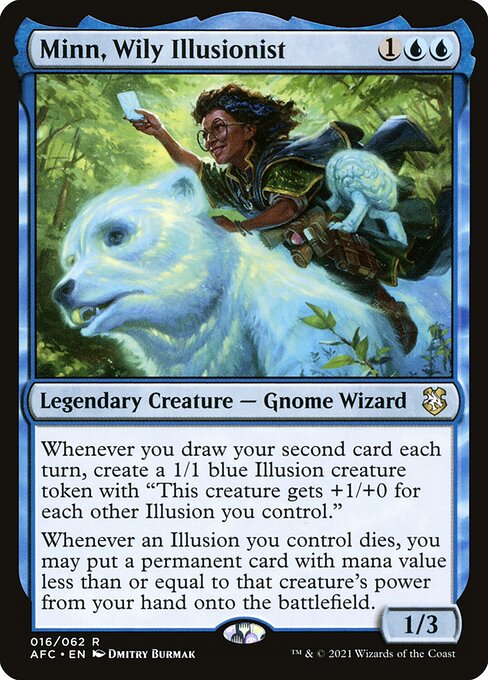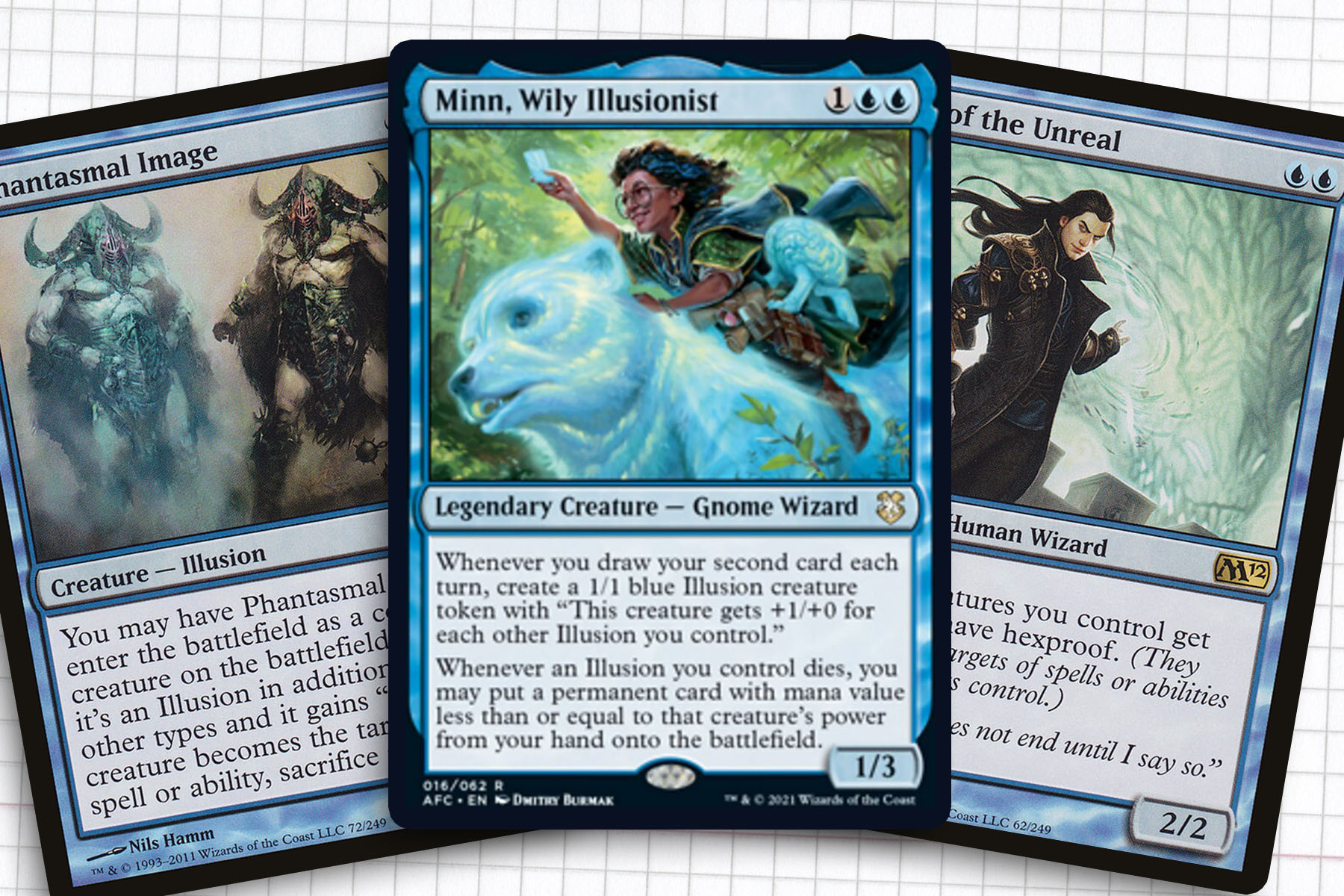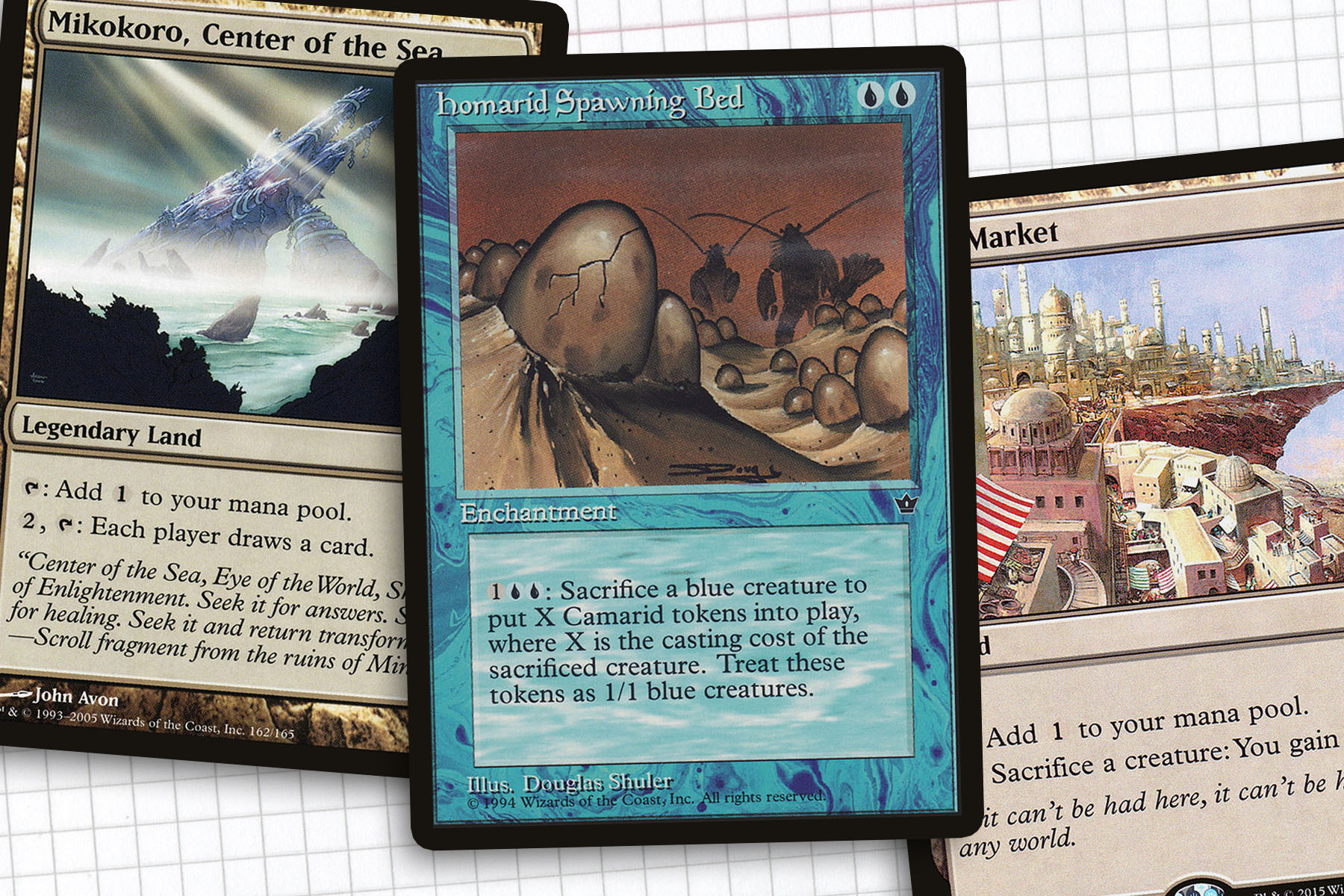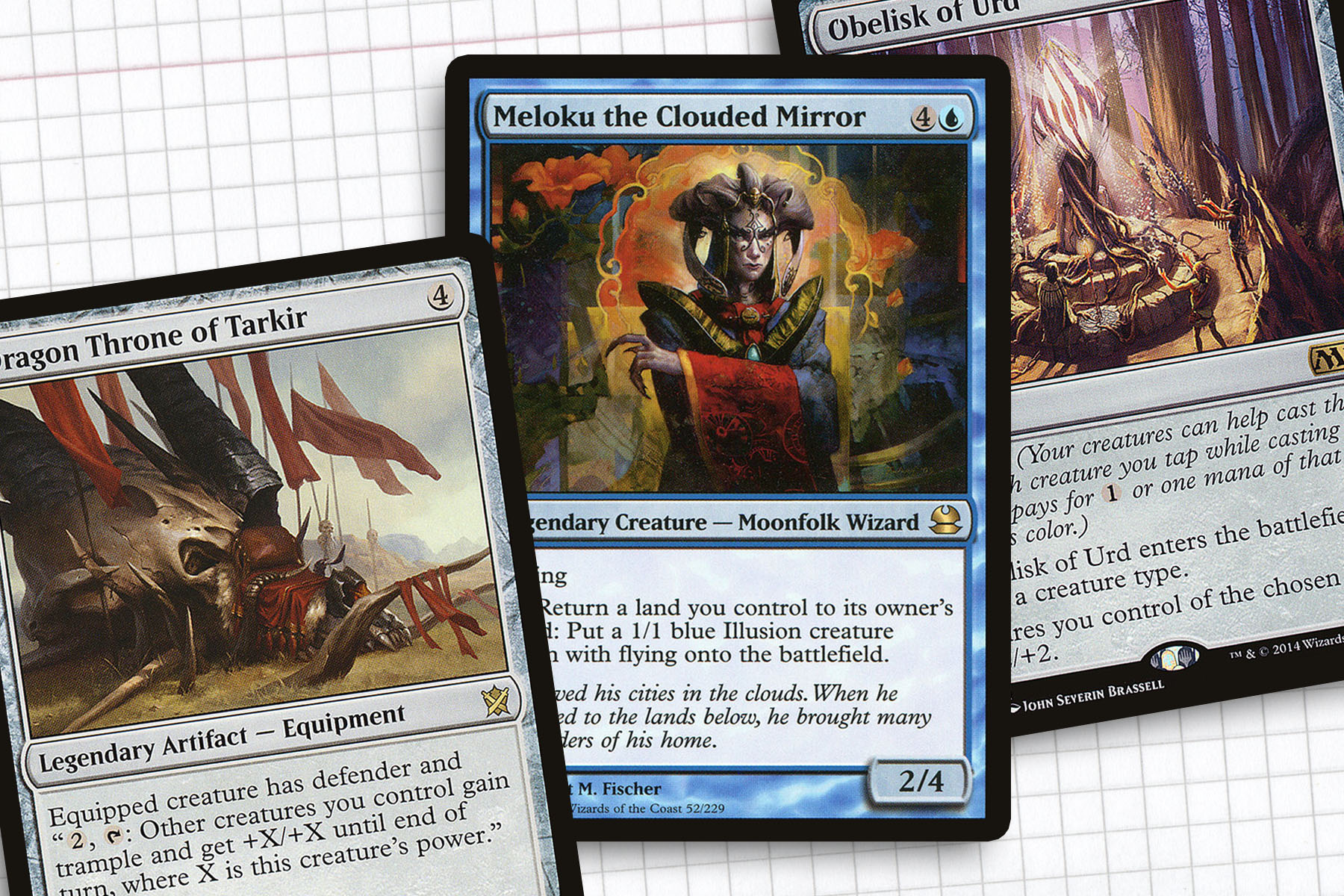Hello and welcome to another week at the apex of the Commander format. With each Standard-legal set now coming with an accompanying set of Commander decks, it becomes a little hard to keep up with all of the incredible cards that have been designed for casual play. But I’m always overjoyed when I take the time to dig through the first time cards and come across a gem like Minn, Wily Illusionist.

Minn is rather open-ended in terms of viable modern legendary creatures. My initial reaction was to try to find the best draw spells and some of the more expensive auras and equipment to make a Voltron deck that also had illusion tokens. I dug through Scryfall and tried to iterate on this deck in an admittedly short period of time, and from there it became abundantly clear that was the wrong route to go down. There is so much synergy between Minn’s two abilities that I was stubbornly overlooking.
In realizing that this deck asks its pilot to move away from trying to compete with the rest of the table by controlling the stack and instead prioritizing permanent spells, I saw an interesting twist on a tribal deck in a color that doesn’t generally swarm the battlefield. This week, we will draw cards, surprise opponents, and win through combat. Mostly.
Commander: Minn, Wily Illusionist
Creatures: Body Double, Clever Impersonator, Draining Whelk, Drowned Rusalka, Glasspool Mimic, Jace’s Phantasm, Krovikan Mist, Lord of the Unreal, Lore Broker, Meloku the Clouded Mirror, Mesmerizing Benthid, Mistform Shrieker, Mistform Skyreaver, Oneirophage, Phantasmal Bear, Phantasmal Image, Phyrexian Metamorph, Riftwing Cloudskate, Spark Double, Toothy, Imaginary Friend, Vesuvan Shapeshifter, Wonder, Zephid
Artifacts: Ashnod’s Altar, Coat of Arms, Door of Destinies, Dragon Throne of Tarkir, Feldon’s Cane, Icon of Ancestry, Midnight Clock, Mimic Vat, Mind Stone, Obelisk of Urd, Sapphire Medallion, Skyclave Relic, Sol Ring, Stoneforge Masterwork, Temple Bell, Trading Post, Witch’s Oven
Enchantments: Arcane Adaptation, Coastal Piracy, Compulsion, Halcyon Glaze, Homarid Spawning Bed, Ominous Seas, Reconnaissance Mission, Reflections of Littjara, Veiled Apparition, Xenograft
Instants: Countervailing Winds, Miscalculation, Neutralize, Supplant Form, Theoretical Duplication, Vision Skeins, Words of Wisdom
Sorceries: Boon of the Wish-Giver, River’s Rebuke, Zndrsplt’s Judgment
Planeswalkers: Jace Beleren, Jace, Cunning Castaway
Lands: 25 Snow-Covered Island, Blasted Landscape, Desert of the Mindful, Geier Reach Sanitarium, Ghost Quarter, Guildless Commons, Halimar Depths, High Market, Lonely Sandbar, Mikokoro, Center of the Sea, Miren, the Moaning Well, Remote Isle, Riptide Laboratory

Illusionary Tribal
I gravitated towards Minn very quickly after the Dungeons of Death deck was unveiled. Minn provides a puzzle that we have come to expect from the generals that are not able to helm the product. These examples generally work within the confines of the deck, but are almost explicitly designed to be taken out and helm their own deck. And we’ve never had an explicit general for the illusion tribe.
For this deck, Minn, Wily Illusionist’s two abilities are doing a lot of heavy lifting, especially as illusions are admittedly a little under-served. Their first ability is pushing us to draw cards consistently, but not en masse, and their second ability is rewarding us for having drawn the cards and maybe not overcommitting too quickly. When these abilities can be self-sustaining and constantly pumping out illusions, we have a pretty tried and true collection of tribal cards in Coat of Arms, Icon of Ancestry, and Obelisk of Urd to allow our tokens to apply pressure to the board. Adding to that, Krovikan Mist, Lord of the Unreal, and Meloku the Clouded Mirror work as a relevant threat, lord, and replacement general, respectively.
Without running the deck through its paces, I didn’t want to assume that our average swath of creatures were going to have considerably high power, even considering the bonus Minn’s tokens have. This is why clone effects, which can be conservatively put into play off Minn’s trigger, felt appropriate for the deck. Not only do they help with the aforementioned unserved nature of the tribe by allowing us to double up on our favorite creatures, but hopefully in losing an illusion we can to cheat out a Clever Impersonator, Phantasmal Image, or Phyrexian Metamorph to keep us at parity with the table and copy something from an opponent.

Magic Timing
As I stated before, Minn would rather have a consistent flow of cards coming into our hand turn after turn, instead of in large bursts. This personally plays to my preferred style in most situations: not being a clear and present danger. To help facilitate the extra card draw, I wanted to employ cards like Geier Reach Sanitarium, Lore Broker, Mikokoro, Center of the Sea, and Temple Bell, to make our token production consistent once we untap with them. Additionally, Compulsion and Drowned Rusalka stood out to me as cheap permanents that would feed into the card draw theme, with the Rusalka doing double duty as a sacrifice outlet.
On-demand sacrifice outlets are going to be key when it comes to Minn’s second ability, as we need to be prepared to take destiny into our own hands. In Commander, you can rarely rely on your opponents to have your interests at heart. So having Ashnod’s Altar or Trading Post in play is going to be key for cheating something like a Draining Whelk or Riftwing Cloudskate to answer problems at a moment’s notice.
While admittedly a pet card, Homarid Spawning Bed works fine on its own, keeping the overall mono blue weenies strategy going; but in combination with Arcane Adaptation or Xenograft, the true potential comes into focus. Being able to sacrifice Toothy, Imaginary Friend or Mistform Skyreaver during combat and creating Illusion Camarid tokens can drastically change the damage Minn’s tokens are dishing out, really bringing home what makes this deck distinct.

Mono Blue Beats
Not since the days of equipping Invisible Stalker with Butcher’s Cleaver in Innistrad Standard have I considered blue to be the aggressive beatdown deck. In fact, beyond Kopala, Warden of Waves, I could not think of a mono blue general that really allowed you to employ a “go wide” tokens strategy.
Because of the nature of Minn’s tokens, I envision wins occurring simply by getting Coat of Arms or Dragon Throne of Tarkir onto the battlefield and alpha striking opponents. In fact, I think there is a lot of potential in Dragon Throne of Tarkir comboing with the right cards in this deck. Stoneforge Masterwork can make any piece of our swarm into Overrun on a stick, a token coming off of Ominous Seas will make the rest of our team just as deadly, and Krovikan Mist takes the threatening body that has been growing with our board and grants that bonus to the rest of the team.
Finally, we have our sub commander, Meloku the Clouded Mirror. The tokens that Meloku creates importantly have flying, which means that they may be able to end games on the back of Door of Destinies or Obelisk of Urd, mimicking a Talrand, Sky Summoner deck. This is why including Wonder became a simple, but almost forgotten addition to the deck, allowing for some redundancy that might not pull focus like Meloku could.
For as much as I saw potential in Minn, Wily Illusionist, it’s fascinating to think back on the early ideas that I had for what to make of them. During an early draft of this deck, I had considered using things like auras to augment my creatures through Eldrazi Conscription or stealing creatures with Spirit Away. But realizing that I wanted to make an illusion tribal deck, it became a little contradictory to try to fuse that mentality with something more akin to Voltron.
Minn was fascinating to me because they helm a blue deck that would rather you minimize the amount of spells in the deck in favor of permanents. I am admittedly a little uncertain with what the optimal build of this deck will look like, but I do wholeheartedly think that a lot of power can come from the tokens Minn creates. I really wish that blue had a card like Second Harvest to allow for token replication with a high ceiling. But if we must work with what we have, I’m pretty pleased with this draft of the deck. Thanks for reading.
Ryan Sainio is a Graphic Designer who writes about EDH and the EDH community. He has been playing Magic: the Gathering since 7th Edition in 2002 and values flavorful and fun gameplay over competitively optimized decks.

